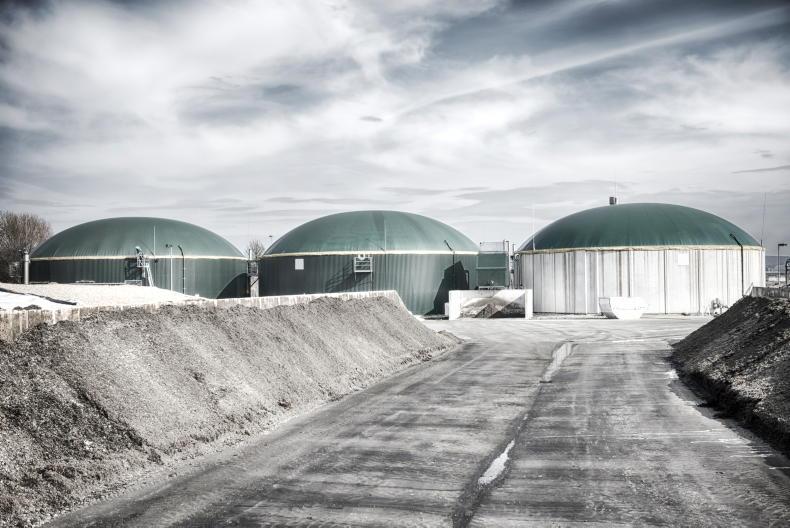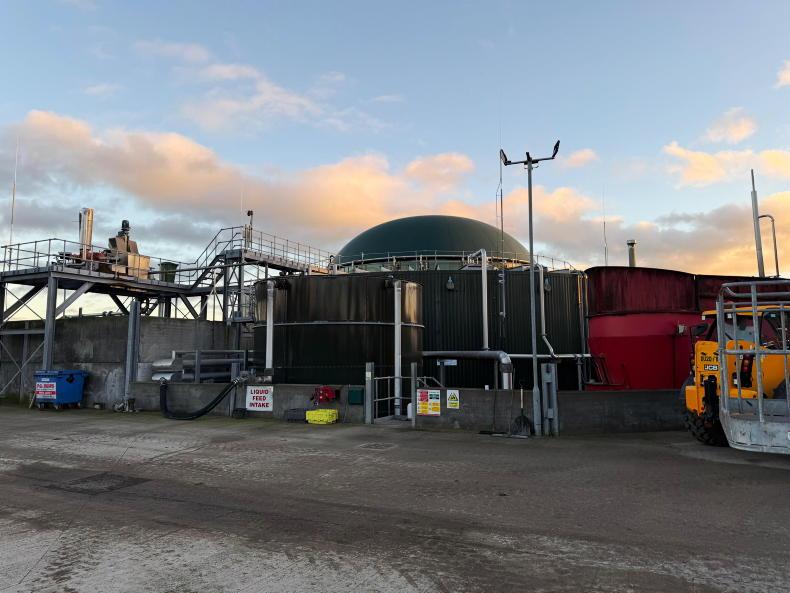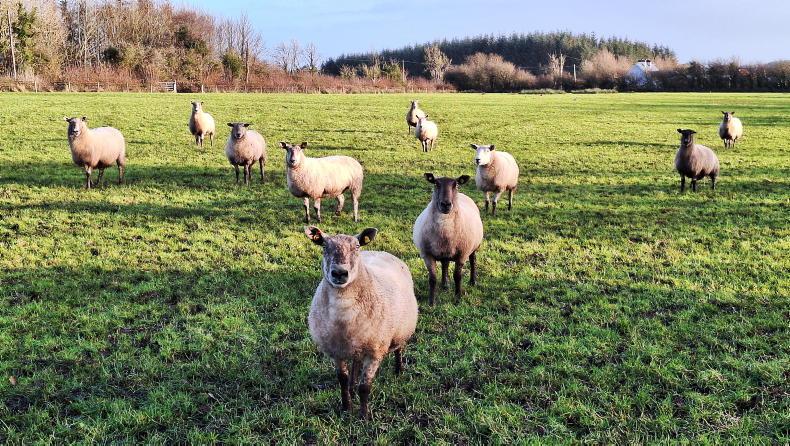Under the Climate Action Plan, Ireland has a target to produce 5.7 terawatt-hour (TWh) of biomethane by 2030. Biomethane is a renewable gas that is chemically identical to natural gas but with a carbon emission intensity 80% to 100% lower. It is produced using anaerobic digestion (AD) technology and is typically supplied with organic waste or agricultural feedstock.
For context, 5.7 TWh is equivalent to 10% of Ireland’s current natural gas demand and would require around 150 to 200 large-scale AD plants to be built by 2030, each at a build cost of €12m to €15m.
While the economics of waste-based AD plants are generally more favourable, especially when a gate fee can be secured, there simply isn’t enough accessible waste in Ireland to meet the 5.7TWh target. Hence, developing a biomethane industry at scale cannot happen without farmers supplying agricultural feedstock.
Slurry is a very useful feedstock for AD plants as it provides a perfect medium to co-digest with other materials, introduces a diverse range of microorganisms into the system, and is vital for helping the biomethane meet strict EU sustainability criteria. However, biomethane yields from slurry are low, which is why other agricultural feedstocks such as grass silage are needed to increase biomethane output.
This presents the potential for a significant new type of farming in Ireland, where farmers produce grass silage and sell it to AD plants.
The scale of this new industry would be immense, requiring approximately 300,000 acres of grass silage annually and nearly 4.5m tonnes of slurry. A capital investment of some €2bn would also be needed to develop this network of plants.
Assuming a conservative price of €40 per fresh-weight tonne for grass silage paid to farmers by AD plants, that would amount to around €240m paid to farmers each year on an area representing less than 2.5% of Ireland’s total agricultural area.
While the majority of emissions savings would go to the energy sector, there would also be a reduction in methane emissions by using slurry as a feedstock, as well as a decrease in the use of chemical fertilisers from using digestate.
The emission credit from this would be attributed to the agriculture sector.
Although this all sounds promising, the challenge lies in the fact that, similar to most solar farms, onshore wind farms, and upcoming offshore wind farms, this technology struggles to be economically feasible without long-term Government support.
Currently, there is no Government support available to help develop these plants. The Government’s biomethane strategy, to be released in the autumn, may provide some indication of what is to come. That said, there are project developers today who are actively attempting to develop new projects in the absence of Government support and are facing significant difficulties.
Alongside the challenges posed by the Irish planning system for AD projects, the market readiness for biomethane and the ability to secure a grid connection are emerging as two other key problem areas.
Cold hard commercial reality
While Ireland’s plans are ambitious, when you talk to current users of natural gas about switching to biomethane, the cold, hard, commercial reality is never far away.
While last year’s record-high gas prices certainly made buying biomethane seem more attractive, the fall in gas prices has brought the old debate of cost versus reward from using renewables right back up again.
The long-term price for natural gas for businesses is around 3.5c/kWh to 4c/kWh. Despite prices still remaining stubbornly high as a result of the Russian invasion of Ukraine, this average is what long-term investment decisions around energy costs will be compared against.
New-build AD plants in Ireland will need at least four times this long-term average for their biomethane gas.

Developing an AD industry from scratch is extremely difficult.
The AD developer also needs a commitment of this price for at least 10 years to stand any chance of securing finance to develop and operate the plant. However, as it stands, very few businesses, regardless of environmental, social and governance (ESG) commitments or impending carbon taxes, are ready to make that investment yet.
While the Government does intend on introducing an obligation in the heat sector in 2024 to encourage the use of renewable fuels such as biomethane, few believe this will achieve much in its current proposed format.

Some €240m could be invested year year in silage.
In the past, the Government has been shy about committing to a price support mechanism for biomethane, similar to what is in place for renewable electricity, instead suggesting that capital grants may be available for developers to get the industry up and going, a world first. However, without that long-term support guarantee, it won’t work and it appears that this message has finally trickled through to Government.
Gas Networks Ireland
A common misconception is that developers sell their biomethane to Gas Networks Ireland (GNI). However, GNI’s role is largely limited to the transportation of gas through their €2.7bn, 14,664km national gas network.
For many plants, the intention is to inject biomethane directly into the GNI network, which allows customers to access and use it. Biomethane developers in turn will enter into gas purchase agreements with those customers.
This means the plant will need to secure and pay for a connection to the network. This is where the current issues arise.
There is currently a high demand for new connections, which is placing a strain on GNI’s resources and is leading to lengthy delays.
Furthermore, as no AD plant is directly connected to the network yet, the legal and technical challenges associated with such connections have yet to be resolved, leading to further delays.
As a result, the cost of securing a network grid connection, despite GNI’s willingness to support this, is increasing, and some quotes, even for relatively short distances, are severely impacting the business case for the plant.
An easy win
To date, securing long-term gas purchase agreements at feasible prices from gas customers has been a challenge for developers. However, it is worth noting that GNI itself is a user of natural gas in order to operate their gas networks, estimated to be around 1TWh per year.
There have been suggestions that GNI could lead by example and replace all of their natural gas usage with biomethane.
By doing so, they could offer developers long-term purchase agreements, while spreading the higher costs among all gas users. This approach would not only kickstart AD development, it would also demonstrate GNI’s commitment to “walking the walk,” so to speak.
Buckets of EU money
The most discouraging aspect of this is that there has never been more funding available within the EU explicitly aimed at developing an innovative biomethane industry in each member state.
Our contacts inform us that despite the potential hundreds of millions of euro available in the EU, there has been no significant progress in accessing these funds, particularly through the National Recovery and Resilience Plan (NNRP).
If only we as a nation had another source of windfall cash that we didn’t know what to do with.
The author Stephen Robb is currently involved in a family/community proposal for an anaerobic digestion facility in Co Donegal.
Under the Climate Action Plan, Ireland has a target to produce 5.7 terawatt-hour (TWh) of biomethane by 2030. Biomethane is a renewable gas that is chemically identical to natural gas but with a carbon emission intensity 80% to 100% lower. It is produced using anaerobic digestion (AD) technology and is typically supplied with organic waste or agricultural feedstock.
For context, 5.7 TWh is equivalent to 10% of Ireland’s current natural gas demand and would require around 150 to 200 large-scale AD plants to be built by 2030, each at a build cost of €12m to €15m.
While the economics of waste-based AD plants are generally more favourable, especially when a gate fee can be secured, there simply isn’t enough accessible waste in Ireland to meet the 5.7TWh target. Hence, developing a biomethane industry at scale cannot happen without farmers supplying agricultural feedstock.
Slurry is a very useful feedstock for AD plants as it provides a perfect medium to co-digest with other materials, introduces a diverse range of microorganisms into the system, and is vital for helping the biomethane meet strict EU sustainability criteria. However, biomethane yields from slurry are low, which is why other agricultural feedstocks such as grass silage are needed to increase biomethane output.
This presents the potential for a significant new type of farming in Ireland, where farmers produce grass silage and sell it to AD plants.
The scale of this new industry would be immense, requiring approximately 300,000 acres of grass silage annually and nearly 4.5m tonnes of slurry. A capital investment of some €2bn would also be needed to develop this network of plants.
Assuming a conservative price of €40 per fresh-weight tonne for grass silage paid to farmers by AD plants, that would amount to around €240m paid to farmers each year on an area representing less than 2.5% of Ireland’s total agricultural area.
While the majority of emissions savings would go to the energy sector, there would also be a reduction in methane emissions by using slurry as a feedstock, as well as a decrease in the use of chemical fertilisers from using digestate.
The emission credit from this would be attributed to the agriculture sector.
Although this all sounds promising, the challenge lies in the fact that, similar to most solar farms, onshore wind farms, and upcoming offshore wind farms, this technology struggles to be economically feasible without long-term Government support.
Currently, there is no Government support available to help develop these plants. The Government’s biomethane strategy, to be released in the autumn, may provide some indication of what is to come. That said, there are project developers today who are actively attempting to develop new projects in the absence of Government support and are facing significant difficulties.
Alongside the challenges posed by the Irish planning system for AD projects, the market readiness for biomethane and the ability to secure a grid connection are emerging as two other key problem areas.
Cold hard commercial reality
While Ireland’s plans are ambitious, when you talk to current users of natural gas about switching to biomethane, the cold, hard, commercial reality is never far away.
While last year’s record-high gas prices certainly made buying biomethane seem more attractive, the fall in gas prices has brought the old debate of cost versus reward from using renewables right back up again.
The long-term price for natural gas for businesses is around 3.5c/kWh to 4c/kWh. Despite prices still remaining stubbornly high as a result of the Russian invasion of Ukraine, this average is what long-term investment decisions around energy costs will be compared against.
New-build AD plants in Ireland will need at least four times this long-term average for their biomethane gas.

Developing an AD industry from scratch is extremely difficult.
The AD developer also needs a commitment of this price for at least 10 years to stand any chance of securing finance to develop and operate the plant. However, as it stands, very few businesses, regardless of environmental, social and governance (ESG) commitments or impending carbon taxes, are ready to make that investment yet.
While the Government does intend on introducing an obligation in the heat sector in 2024 to encourage the use of renewable fuels such as biomethane, few believe this will achieve much in its current proposed format.

Some €240m could be invested year year in silage.
In the past, the Government has been shy about committing to a price support mechanism for biomethane, similar to what is in place for renewable electricity, instead suggesting that capital grants may be available for developers to get the industry up and going, a world first. However, without that long-term support guarantee, it won’t work and it appears that this message has finally trickled through to Government.
Gas Networks Ireland
A common misconception is that developers sell their biomethane to Gas Networks Ireland (GNI). However, GNI’s role is largely limited to the transportation of gas through their €2.7bn, 14,664km national gas network.
For many plants, the intention is to inject biomethane directly into the GNI network, which allows customers to access and use it. Biomethane developers in turn will enter into gas purchase agreements with those customers.
This means the plant will need to secure and pay for a connection to the network. This is where the current issues arise.
There is currently a high demand for new connections, which is placing a strain on GNI’s resources and is leading to lengthy delays.
Furthermore, as no AD plant is directly connected to the network yet, the legal and technical challenges associated with such connections have yet to be resolved, leading to further delays.
As a result, the cost of securing a network grid connection, despite GNI’s willingness to support this, is increasing, and some quotes, even for relatively short distances, are severely impacting the business case for the plant.
An easy win
To date, securing long-term gas purchase agreements at feasible prices from gas customers has been a challenge for developers. However, it is worth noting that GNI itself is a user of natural gas in order to operate their gas networks, estimated to be around 1TWh per year.
There have been suggestions that GNI could lead by example and replace all of their natural gas usage with biomethane.
By doing so, they could offer developers long-term purchase agreements, while spreading the higher costs among all gas users. This approach would not only kickstart AD development, it would also demonstrate GNI’s commitment to “walking the walk,” so to speak.
Buckets of EU money
The most discouraging aspect of this is that there has never been more funding available within the EU explicitly aimed at developing an innovative biomethane industry in each member state.
Our contacts inform us that despite the potential hundreds of millions of euro available in the EU, there has been no significant progress in accessing these funds, particularly through the National Recovery and Resilience Plan (NNRP).
If only we as a nation had another source of windfall cash that we didn’t know what to do with.
The author Stephen Robb is currently involved in a family/community proposal for an anaerobic digestion facility in Co Donegal.












SHARING OPTIONS